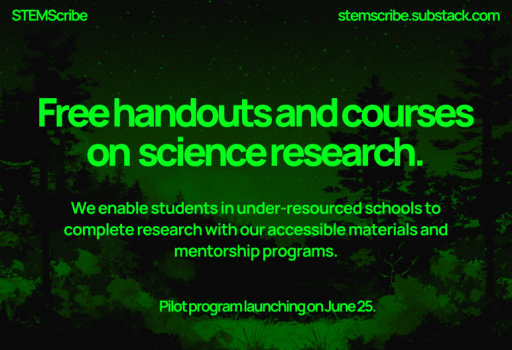Robotics in Surgery and ChatGPT: Making Humans and Google Obsolete?
Your curated selection of student work on science.
Issue #4
Subscribe to the STEMScribe newsletter to gain full access to our materials. It’s free!
Once a week, we write this email to share student-written work on science. Please spread the word to support us and win referral awards!
Can Robots Ever Replace Surgeons?
“Life is short, Art is long,” is the beginning of Hippocrates’ First Aphorism. This phrase reflects the fact that human life is brief in comparison to the endless skills to be explored beyond one’s lifetime, yet their ever-evolving art lives eternally. Hippocrates could never have imagined the motorized machines used in modern healthcare, let alone the countless robots and artificial intelligence (AI) that have been melded into medicine worldwide.
The Da Vinci surgical robot is now an integral tool in the surgical field and crucial to minimally invasive surgeries, boasting over 10 million procedures. Its three to four arms offer a range of intricate and meticulous movements that according to the system’s developer are “beyond the limits of the human hand.” The demand for high-tech surgical robots has only continued to rise, with companies such as Vicarious Surgical and Neuralink entering the market, Vicarious being financially backed by major revolutionizers in technology Bill Gates and Vinod Khosla.
All these technologies require a trained surgeon to operate them behind the scenes, reinforcing professionals' confidence in the security of their positions. Yet, with the advancement of technology, how long until these dependent machines become entirely autonomous? The question inevitably arises. Can these machines someday single-handedly dominate the surgical field, eradicating human practitioners?
Although the precision of robots may be well beyond the reach of the human hand, the techniques are only half the art of medicine. The other half calls upon the genuine empathy and compassion of medical professionals, and their abilities to apply well-known knowledge to patients, carefully considering individual circumstances and mentalities. The truth is, no one wants to be greeted by a cold, metallic hand before life-changing surgeries, or cry to a sterilized apparatus after being diagnosed with cancer. Surgery isn’t just a series of procedures ended when the last stitch is placed. It exists beyond the operating table, with layers of communication and trust put into building a patient-physician relationship, something a robot can never emulate.
In a study conducted in 2019, over 200 participants were offered free assessment of their stress level, with 40% of participants signing up when informed they would be assessed by a doctor, and only 26% accepting when told a computer would assess them. The researchers found that patients valued their individuality and believed that a standardized computer could not meet their unique needs….
Read more about the necessity of human medical professionals.
The Problem with Horses and Google. The ChatGPT Solution.
Hundreds of years ago, if you needed the opinion of an expert, you grabbed your horse and traveled until you found someone who could answer your question. Now? We have Google.
At our fingertips is a huge database of information. Want the latest information on the Trump court trial? Don't worry, you can choose to read about it from all the major news outlets. Conflicted on whether to drive four hours to see a total solar eclipse? Well, here are billions of links to people discussing the same topic.
Google is perfect when we want expert clarification. But what about everyday queries? These require a few seconds of thought to answer — the "can I touch a metal spoon in an airfryer?" and "should I use sunscreen if I'm going to the beach?" questions. Still, humans are intrinsically efficient animals. Given an opportunity to be lazy, we almost never choose the option requiring hard work. So, we default to Google for trivial questions.
Take a look at your most recent Google search. Imagine you lived in the age before electronic communication. Would you take your horse and start riding to the next town, or would you be able to answer it with a moment of rational thought?
We are becoming less reliant on our own thoughts and more reliant on an easily accessible conglomerate of thoughts: the Google hivemind. This means we spend less time being curious and less time trying to satiate our curiosity. After all, we can always just "google it." This isn't a new revelation. For years, studies have shown that our dependence on technology negatively impacts our brains.
Large Language Models (LLMs) like ChatGPT have taken this reliance a step further. Strangely, they combine the best aspects of the horse-and-buggy and Google eras. To understand this, we must first examine the critical area in which search engines are lacking.
Read more about our reliance on convenient searching.
Announcement!
If you are an educator, professional in STEM, or high school graduate with experience in science research, please reach out to us at stemscribe.director@gmail.com to learn how you can support our mission.
STEMScribe will soon be branching out into a new direction.
Sign up to receive the handouts early:
Stay tuned, and stay curious.
The STEMScribe blog is a reader-supported publication. Subscribe to show your support. It’s free!
If you would like to submit a guest post to the blog, please fill out this form. Join the Discord server to gain access to our free tutoring and mentorship services.




